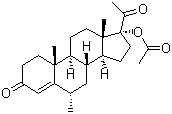Medroxy Progesterone 17-Acetate
-
- Category :
Pharmaceuticals and Biochemicals
- CAS NO : 71-58-9
- EC NO : 200-757-9
- Molecular Formula : C24H34O4
- Main Specifications : 99% up
- Synonyms : medroxyprogesterone 17-acetate;hydroxymethylprogesterone acetate;17alpha-acetoxy-6-alpha-methylpregn-4-ene-3,20-dione;17a-hydroxy-6a-methyl-4-pregnene-3,20-dione acetate;depo-provera;(6-alpha)-17-(acetyloxy)-6-methylpreg-4-ene-3,20-dione;17-(acetyloxy)-6-methyl-(6-alpha)-pregn-4-ene-20-dione;17-(acetyloxy)-6-methyl-20-dion(6alpha)-pregn-4-ene-;17-acetoxy-6-alpha-methylprogesterone;17-alpha-hydroxy-6-alpha-methylpregn-4-ene-3,20-dioneacetate;17-alpha-hydroxy-6-alpha-methyl-progesteronacetate;17-alpha-hydroxy-6-alpha-methylprogesteroneacetate;17-hydroxy-6-alpha-methylpregn-4-ene-3,20-dioneacetate;(17-acetyl-6,10,13-trimethyl-3-oxo-1,2,6,7,8,9,11,12,14,15,16,17-dodecahydrocyclopenta[a]phenanthren-16-yl) acetate;Medroxy progesterone Acetate;
Package: 25kg/drum
Uses : It is used as birth control and as part of menopausal hormone therapy
Molecular Structure:

Product description:
Description:
Medroxyprogesterone acetate is a progestin, a synthetic variant of the human hormone progesterone and a potent progesterone receptor agonist.Target: Progesterone ReceptorMedroxyprogesterone acetate(MPA) is a steroidal progestin, a synthetic variant of the human hormone progesterone. It is used as a contraceptive, in hormone replacement therapy and for the treatment of endometriosis as well as several other indications.
MPA is a more potent derivative of its parent compound medroxyprogesterone (MP). While medroxyprogesterone is sometimes used as a synonym for medroxyprogesterone acetate, what is normally being administered is MPA and not MP [1, 2].
Application
Medroxyprogesterone acetate is a synthetic progestin that is derived from 17-hydroxyprogesterone. It is used as birth control and as part of menopausal hormone therapy. It is also used to treat endometriosis, abnormal uterine bleeding, abnormal sexuality in males, and certain types of cancer.
Though not used as a treatment for epilepsy, MPA reduces the frequency of seizures and does not interact with antiepileptic medications. MPA does not interfere with blood clotting and appears to improve blood parameters for women with sickle cell anemia. Similarly, MPA does not appear to affect liver metabolism, and may improve primary biliary cirrhosisand chronic active hepatitis.
Women taking MPA may experience spotting shortly after starting the medication but is not usually serious enough to require medical intervention. With longer use amenorrhoea can occur as can irregular menstruation which is a major source of dissatisfaction, though both can result in improvements with iron deficiency and risk of pelvic inflammatory disease and often do not result in discontinuing the medication.
